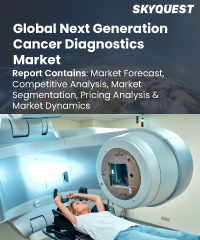
Report ID: SQMIG35A2226

Report ID:
SQMIG35A2226 |
Region:
Global |
Published Date: September, 2024
Pages:
219
|
Tables:
67 |
Figures:
77
Next Generation Cancer Diagnostics Market Drivers
Rising Demand for Personalized Medicines to Bolster Market Growth
Growing Awareness about Early Cancer Detection
Next Generation Cancer Diagnostics Market Restraints
Reimbursement Issues to Hinder Market Growth
Our industry expert will work with you to provide you with customized data in a short amount of time.
REQUEST FREE CUSTOMIZATIONWant to customize this report? This report can be personalized according to your needs. Our analysts and industry experts will work directly with you to understand your requirements and provide you with customized data in a short amount of time. We offer $1000 worth of FREE customization at the time of purchase.

Report ID: SQMIG35A2226